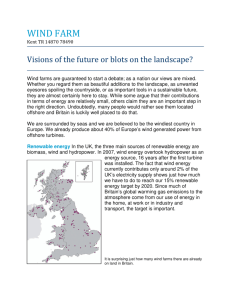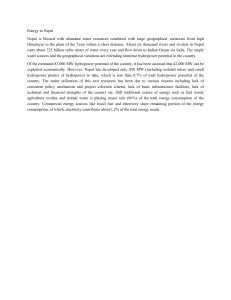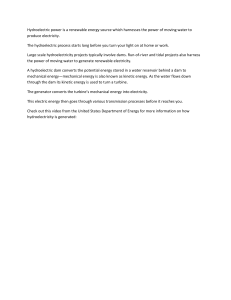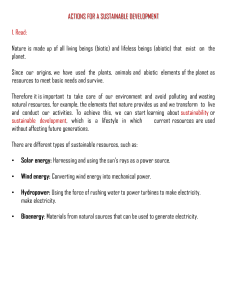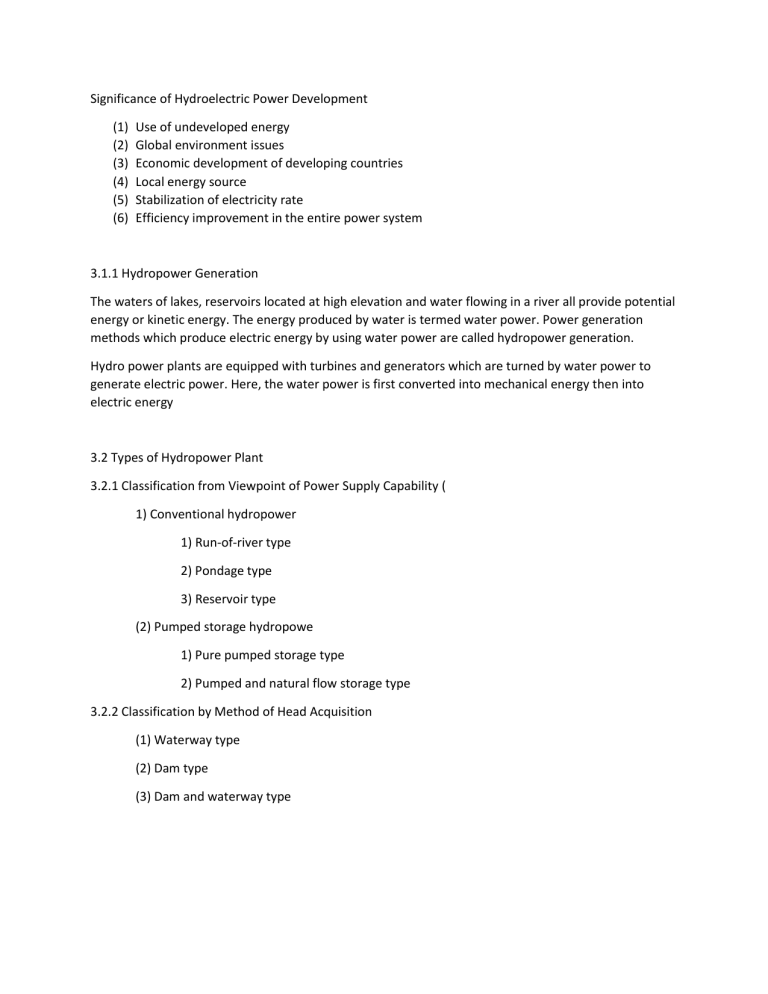
Significance of Hydroelectric Power Development (1) (2) (3) (4) (5) (6) Use of undeveloped energy Global environment issues Economic development of developing countries Local energy source Stabilization of electricity rate Efficiency improvement in the entire power system 3.1.1 Hydropower Generation The waters of lakes, reservoirs located at high elevation and water flowing in a river all provide potential energy or kinetic energy. The energy produced by water is termed water power. Power generation methods which produce electric energy by using water power are called hydropower generation. Hydro power plants are equipped with turbines and generators which are turned by water power to generate electric power. Here, the water power is first converted into mechanical energy then into electric energy 3.2 Types of Hydropower Plant 3.2.1 Classification from Viewpoint of Power Supply Capability ( 1) Conventional hydropower 1) Run-of-river type 2) Pondage type 3) Reservoir type (2) Pumped storage hydropowe 1) Pure pumped storage type 2) Pumped and natural flow storage type 3.2.2 Classification by Method of Head Acquisition (1) Waterway type (2) Dam type (3) Dam and waterway type Compared to other clean energy sources (e.g. wind and solar) it has achieved high levels of technological maturity. 3.1 Energy conversion: from water to power Hydropower is considered a renewable form of energy because it is based on solar energy that drives the hydrologic cycle (see Figure 3-1). The hydrologic cycle refers to the following process: the sun heats water (about 97 percent from oceans); water evaporates; rising air currents transport water vapour to the upper atmosphere where lower temperatures condense vapour into clouds. Air currents move the clouds around the globe and eventually, water falls as precipitation. Through this process, water can reach altitudes higher than sea level. Gravity causes water to descend from higher elevations creating opportunities to harness water energy—gravitational energy from falling water and kinetic energy from flowing water. The amount of kinetic energy available from water flow depends on the height from which the water drops, the angle of the slope, and the volume of water per unit of time, i.e., the discharge. The energy of flowing water is harnessed by turbines, which are placed in the path of the water flow. The force exerted by water moving over turbine blades rotates the turbine runner; the turbine runner rotates the generator, which produces electricity. 3.3 Brief history of hydropower development The mechanical energy of water has been harnessed for production since ancient times. Early uses included irrigation, grinding grain, sawing wood and manufacturing textiles, among others. Water current energy was converted by water wheels into useful forms of power; the invention of the water wheel dates to 3rd Century BC. During the industrial revolution hydro turbines gradually replaced waterwheels because turbines could exploit head much larger than their diameter and offered significantly higher efficiencies. Using hydropower for electricity generation dates to 19th C., making it the first renewable energy source to produce electric power. Today it remains the most common form of renewable energy and plays an important role in electric power generation worldwide (see Table 3-1). For a brief overview of technology development from ancient to modern times see Box 3-1. 3.4 Advantages and disadvantages of hydropower Compared with other technologies, the most important advantages of hydropower are the following: • Hydropower generation is based on a reliable proven technology that has been around for more than a century and hydropower plants can be easily rehabilitated or upgraded utilizing recent advances in hydro technologies. • Hydropower generation is renewable because it does not reduce the water resources it uses and does not require fuel. • In most cases, hydropower is an economically competitive renewable source of energy. The levelized cost of electricity (LCOE) is usually in the range of US$0.05 to US$0.10 per kWh [EIA 2010]. Rehabilitating or upgrading existing hydropower schemes provides opportunities for cost-effective capacity increases. • Hydropower exploits domestic water resources, thereby achieving price stability by avoiding market fluctuations. • Storage hydropower schemes (dams, pumped storage) offer operational flexibility because they can be easily ramped up or shut down, creating potential for immediate response to fluctuations in electricity demand. Thus storage hydros are valuable to meet peak demand or to compensate for other plants in the grid (especially solar and wind), which can experience sudden fluctuations in power output. • The creation of reservoirs also allows water to be stored for drinking or irrigation, reducing human vulnerability to droughts. Reservoirs can provide flood protection, and can improve waterway transport capacity. Further, HPPs with reservoirs can generate energy during dry periods and regulate fluctuations in the energy supply network by using the stored water. • Environmental impacts triggered by implementing hydropower schemes are well known and manageable. Disadvantages of hydropower include the following: • High up-front investment costs compared to other technologies, such as thermal power (but low operational costs since no fuel is required). • Reservoirs may have a negative impact on the inundated area, damage river flora and fauna, or disrupt river uses such as navigation. However, most negative impacts can be mitigated through project design. The IFC and other multilateral financial institutions have strict mandatory requirements for assessment and mitigation of social and environmental impacts. It=s a form of energy … a renewable resource. Water, when it is falling by the force of gravity, can be used to turn turbines and generators that produce electricity. Hydroelectric power comes from water at work, water in motion. In nature, energy cannot be created or destroyed, but its form can change. Generating Power In generating electricity, no new energy is created. Actually one form of energy is converted to another form. To generate electricity, water must be in motion. This is kinetic (moving) energy. When flowing water turns blades in a turbine, the form is changed to mechanical (machine) energy. The turbine turns the generator rotor which then converts this mechanical energy into another energy form -- electricity. Since water is the initial source of energy, we call this hydroelectric power or hydropower for short. At facilities called hydroelectric powerplants, hydropower is generated. The reservoir acts much like a battery, storing water to be released as needed to generate power. The dam creates a Ahead@ or height from which water flows. A pipe (penstock) carries the water from the reservoir to the turbine. The fast-moving water pushes the turbine blades, something like a pinwheel in the wind. The waters force on the turbine blades turns the rotor, the moving part of the electric generator. When coils of wire on the rotor sweep past the generator=s stationary coil (stator), electricity is produced. This concept was discovered by Michael Faraday in 1831 when he found that electricity could be generated by rotating magnets within copper coils. When the water has completed its task, it flows on unchanged to serve other needs. Transmitting Power Once the electricity is produced, it must be delivered to where it is needed -- our homes, schools, offices, factories, etc. Dams are often in remote locations and power must be transmitted over some distance to its users. Vast networks of transmission lines and facilities are used to bring electricity to us in a form we can use How Power is Computed Two factors determining the actual output of energy at a dam: (1) Volume of water released /discharge/ and (2) Vertical distance of waterfall/head/ -- Hydroelectric powerplants do not use up limited nonrenewable resources to make electricity. -- They do not cause pollution of air, land, or water. -- They have low failure rates, low operating costs, and are reliable. --They can provide startup power in the event of a system wide power failure. 1.2 ENERGY SOURCES There are six ultimate sources of useful energy: (1) The sun; (2) The motion and gravitational potential of the sun, Moon and earth; (3) Geothermal energy from cooling, chemical reaction and the radioactive decay inside the earth; (4) Nuclear reactions on the earth; (5) Chemical reactions from mineral sources; and (6) Fossil fuel (Petroleum product and gases). 2.1 Main components of a hydropower plant Hydropower is based on a very simple physical concept. Hydropower plants convert the potential or gravitational energy of water first into mechanical and then into electrical energy: the flow of water turns a turbine, which is connected to a generator. The electricity generated then flows to a substation, where the voltage is increased, and is then distributed to the end user or fed into the power grid. Hydropower is a renewable energy as it is based on the water cycle, which is an endless, constantly recharging system. Hydropower is a site-specific technology and needs to be tailored to the specific features of the local hydrology, topography and geology. However, while the design changes according to local conditions, the main components highlighted in Figure 2-1 are the basic elements of conventional hydropower plants. Gates are barriers that allow to regulate water release. They can take different forms, such as fixed wheel gates, sliding gates, radial gates, and caterpillar gates, and they are used for power intakes, bottom outlets, or river diversion works. Spillway gates are also used to control flood discharge in reservoirs. When gates on the dam open, water flows down the penstock to the turbine, usually through a shut-off valve. The penstock is a conduit or pipe that conducts water from the intake to the powerhouse. Penstocks are usually made of steel and they must be able to withstand high pressures on the inside surface in the event of a sudden increase or decrease in the load - the so-called water hammer. If the powerhouse is located far from the dam and reservoir, water is transferred by open channels, tunnels under pressure, or pressure shafts, which depending upon the rock type can be unlined, lined with concrete or steel lined. Sufficient water head should be available above the intake entrance to avoid the formation of vortices which may carry air into the penstock and result in problems with turbine operation. A surge tank is often introduced in the system between the water intake and the powerhouse to absorb any water surges caused in the penstock or pressure tunnel due to the sudden loading and unloading of the generator through opening and closing of the inlet valve and wicket gates. The wicket gates of the turbine allow regulation of the amount of water that flows into the turbine. The turbine is the machine that converts the kinetic/potential energy of water into mechanical energy. It is attached by way of a shaft to the generator, which transforms the mechanical energy of the turbine into electric energy. The turbine and the generator are at the heart of the hydroelectric power plant. Electricity is generated by the rotating magnetic field created by the spinning rotor, a series of large electromagnets, inside a tightly wound coil of copper wire, called the stator. The alternating current thus produced is transferred to the transformer, which converts it to a higher voltage. Finally, the high voltage electricity is transmitted to the power line. The water that passed the turbine flows through the draft tube into the tailrace channel and re-enters the river downstream.


